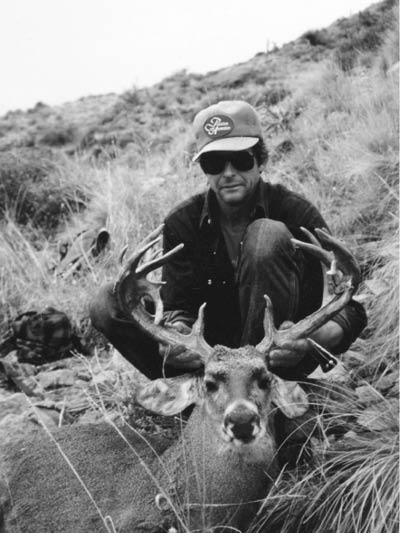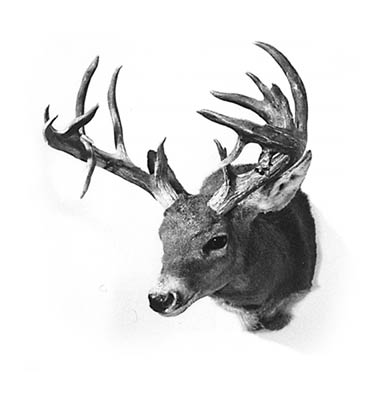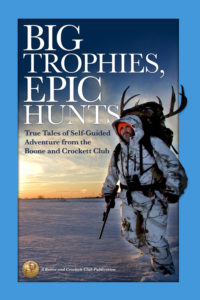For several years, I had been helping a friend of mine by the name of Mick Holder with cow work and such on his ranch in Gila County, near Globe, Arizona. I have been in the cattle business most of my life and am an avid hunter. Until I met Mick, I had never been particularly interested in hunting the Arizona Coues’ whitetail deer. He had hunted them all his life and had guided for Coues’ deer and black bear for many years. He had reached the point in his life where he did not care to guide anymore. He just enjoyed hunting with friends and interesting people he had met through the years. Mick is one of the keenest and most knowledgeable observers of nature I have ever seen.
Coues’ deer season in Arizona generally takes place during the last half of December. The weather is cool to cold, depending on weather systems moving through the state at the time. December of 1988 was especially good, because we had several storms and a fair amount of snow at the higher elevations. Conditions were perfect to start the Coues’ deer into the rut.
We hunted a few days in rain and fog, seeing lots of deer. I had in the past killed several nice Coues’ bucks and was only interested in a good trophy. The country we like to hunt is rough, steep, rocky mountain sides. They have a good combination of browse and grass but not too much brush. We like to use spotting scopes as much as possible to save time and movement. Many times, I have walked right by smart bucks and have learned to glass them up first. We prefer to hunt with 7mm magnums, because they provide the advantage of flat trajectory for a long shot if you are unable to make a close stalk.

Sure enough, I heard a few rocks roll above and ahead of me and got a good look at a fine trophy buck moving out of sight in a hurry. A quick test for a records-book buck is whether his antlers are wider than his ears and his rear tines are more than 6 inches long. This buck had them but was moving too fast and I couldn’t get the shot.
I finished the day, met Mick that night, and told him what I had seen. We both agreed we should make another try for the buck the next day. There were no other hunters in the area, and we hoped he would stay close, so we could glass him. We planned the hunt that night, though we could not agree on how to do it. We had both hunted this mountain several times. He had his ideas; I had mine.
The next morning, we were on the mountain before daylight and had another parley on how to hunt that day. Mick told me that, from his years of experience with Coues’ deer, he really did not think the buck would be where I thought he would be. I finally had to modify my plan and we started up the mountain. I went high, and Mick stayed below me.
The higher I climbed, the more draws and other likely hiding places I wanted to check out. Anybody who has hunted Coues’ deer very long knows they will hold tight. I did not follow our plan and got behind the sweep we had planned to make across the face of the mountain. I knew I was behind and was mad at myself. Mick was out of sight, ahead and below me.
I had to cross a big, very steep rockslide. Trying to be quiet was almost impossible, but I crossed carefully and started to move forward. I had not taken three steps when a buck stood up. He was about 50 yards away and a little below me. He started running but not fast, down and away and to my right. When he first got up, I knew he was good, but when he moved a little and turned his head sideways, I could hardly see through his antlers.
Instantly, I sat down and took careful aim. My heart was in my throat as I squeezed off the shot. Click. I had forgotten to put a round in the chamber. I worked the bolt, thinking, “I’m going to get behind if I don’t do it right.”
I took careful aim again, fired and bolted in another round. He was still moving and about 80 yards away. I fired again and bolted in another round. He kept running, but suddenly, he stopped about 125 yards away and looked back at me. I thought, “Boy, I’ve got to do it now.”
I fired again. He turned and ran down the mountain into a draw, where he passed out of sight. I pulled one more round out of my pocket and put it into the chamber, throwing the balance of the cartridges in my pocket out on the ground so I could reach them quickly if I needed them. I waited for him to show himself crossing the draw, but he did not and I moved to check for blood. I found the blood trail. He had run another 50 yards and was lying in some rocks and tall grass.

I stood up and began examining his antlers. One major drop tine had been broken but was still attached by old velvet. He either broke it when he fell, or he broke it fighting. I knew it would hurt his score. It took Mick a while to get to me. When he arrived, his mouth dropped open, and neither of us could say anything. Finally, he said, “Erickson, it looks like you have had a good December.”
We finished field-dressing the buck and started off the mountain. I fell into some prickly pear on the way down, which marred a perfect day and brought me back to reality. Nothing is perfect. Of course, the argument about the buck I had seen the day before started again. I finally agreed that Mick was right, as usual, but look at the result of my disagreement.
Official Measurer’s Note:
As we noted elsewhere, some trophy antlers or horns just scream “exceptional” in photos. Many others don’t—no matter how high their scores. This buck, in the writer’s opinion, never fails to impress in photos or in antler configuration. It is true that large Coues’ whitetail trophies tend to be impressive relative to the diminutive size of this subspecies, especially in terms of antler mass versus skull size. That all said, Erickson’s award-winning (currently ranked No. 5) non-typical Coues’ whitetail more or less has it all in terms of key visual attributes and scoring metrics. Namely, the buck possesses a strong inside spread credit of 16-6/8 inches. Only a dozen other top Coues’ deer trophies match or exceed that measure. The buck also has main beams approaching 20 inches each, which fairly equates to the 30-inch main beams found in top-ranking whitetail trophies. Lastly, Erickson’s Coues’ deer ranks just below the top 10 in terms of total length of the abnormal points which lend to the great aesthetic character of this buck. In particular, inward curving drop tines coming off both main beams give this particular deer its own unique visual appeal.

Thirty hunters. Thirty record-book trophy big game animals, most of them taken without guides on public lands. Thirty epic tales to share back at hunting camp. These are the real-world stories behind some of the top-scoring trophies ever recognized by the Boone and Crockett Club.

